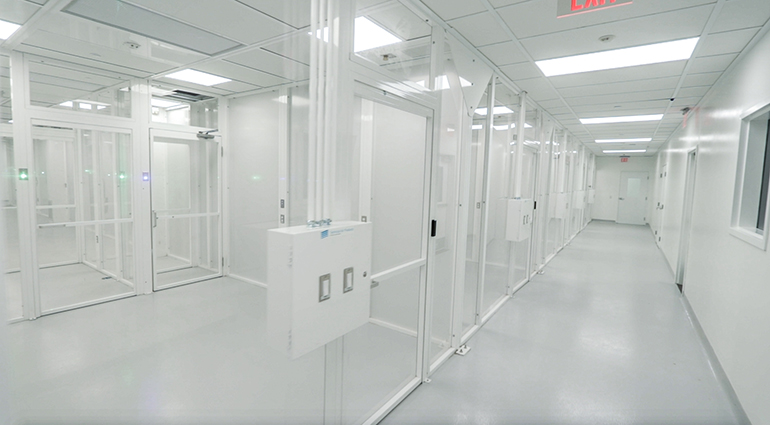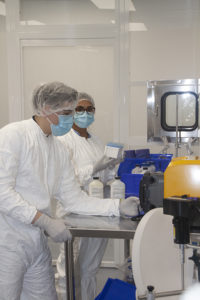 The transition from R&D to pharma manufacturing can be a pretty high hurdle to clear for many companies in the life sciences industry. Scaling up to a manufacturing process requires a considerable investment in time and money – and a thorough knowledge of current Good Manufacturing Practices (cGMP).
The transition from R&D to pharma manufacturing can be a pretty high hurdle to clear for many companies in the life sciences industry. Scaling up to a manufacturing process requires a considerable investment in time and money – and a thorough knowledge of current Good Manufacturing Practices (cGMP).
Larger companies typically have in-house experts or previous experience operating in a cGMP environment; for most, however, the fundamentals of cGMP are unfamiliar territory.
This can be as basic as proper attire and personnel flow within a facility. In a research lab, a lab coat and goggles may be all that’s necessary, and personnel can move within the facility without giving it a second thought. Manufacturing is a whole new ball game. Scrubs and tie backs over suits, gloves and boots are often required, and proper personnel flow through the space is critical, as is the movement of materials through that space. Improper personnel or material movement can have a significant impact to facility operations and can even introduce particulate or microbiological contamination to the point of compromising an entire batch during manufacturing.
So what are the basics to keep in mind when building a foundation for Good Manufacturing Practices? Here are three key areas to give you an idea of what’s required:
- Quality mindset
- Personnel training and development
- Phase appropriate cGMP
Quality mindset
Adopting a quality mindset at the outset when designing your process or facility is critical. Beginning with the end in mind of being a Quality Organization, accountable for all aspects of product quality, allows better risk evaluations and application of the right resources at right time in the lifecycle.
For example, from a new facility perspective, is the space appropriate to the work? Is the floor strong enough to support the large pieces of equipment required for the process? Is the floor stain and scratch resistant? Is the floor anti-slip when wet? Is the ceiling of the appropriate height to accommodate the equipment, especially for modular or contract manufacturers? Is the paint appropriate for the GMP spaces? Have you addressed flammable cabinets, sprinkler and suppression systems? If you’re piping any type of compressed gas into a clean room, are you using the appropriate pipe material and connection types?
 Your facility must have the right infrastructure to safely produce what you are manufacturing. This often requires meeting health and safety requirements, local municipal requirements and product manufacturing requirements – all under the umbrella of meeting and maintaining GMP requirements under normal operations.
Your facility must have the right infrastructure to safely produce what you are manufacturing. This often requires meeting health and safety requirements, local municipal requirements and product manufacturing requirements – all under the umbrella of meeting and maintaining GMP requirements under normal operations.
In addition to facility design, consideration for the following types of utilities needs to be evaluated, which may or may not be subject to cGMP requirements: electrical, compressed gases, water, steam, liquid nitrogen, HVAC, natural gas, and recently, solar. If the use of the utility has impact on an activity in the cGMP environment, then that utility may be subject to additional scrutiny to make it suitable for cGMP requirements.
In transitioning from an R&D to a cGMP organization, a significant amount of upgrades or remediation may be required. Depending on the extent of the modifications, coordination with various utility companies, vendors, local city offices can be extremely challenging and can add months to your schedule, even before giving consideration to actual cGMP readiness activities.
The answers to all of the questions raised here, and numerous more, are essential in the proper design and ultimately compliance of the facility during its manufacturing lifecycle. For companies just starting off in manufacturing, the learning curve can be a real challenge.
Personnel training and development
It may seem elementary, but its importance cannot be understated: Good Manufacturing Practices require personnel that are trained, qualified and understand what they’re doing. This starts with developing a strong Quality organization.
There’s a mountain of paperwork that comes with manufacturing in accordance with cGMP, and it all falls in the lap of the Quality division. In addition to the mountain of documentation required to manufacture in an FDA-regulated environment, transitioning from an R&D to a cGMP state requires keeping track of a multitude of local regulations and requirements. That includes local codes and regulations for the towns in which they operate, as well as those in the surrounding areas.
Restrictions and regulations may vary greatly in areas just a few miles apart, and management must successfully navigate these requirements. They must learn these differences, as well as which governing bodies in those areas are responsible for permit applications. An unexpected delay in permitting could lead to a corresponding delay in the timing of manufacturing.
Appropriate training and development – and many times, retaining technical consulting expertise – to manage all these requirements and to balance against cGMP requirements is among the key roles of the Quality organization. The team lead must have a strong knowledge of manufacturing processes, as well as how to transfer knowledge from the R&D environment and incorporate the demands of a larger, more complex and more stringent facility.
Engineers or specialists oversee each part of the process – from the selected materials used in manufacturing; to the approved vendors of those materials; to how the materials are received, tested, inventoried and made ready for processing. And that’s before any part of the manufacturing actually begins. The leadership team lead must be able to see the lay of the land, to understand the whole picture, the value of each step and where to pause if necessary.
Phase-Appropriate cGMP
As many companies transition from an early stage or R&D organization to a cGMP facility, they must design and operate in an environment that is appropriate for their development. Not all aspects of cGMP are created equal! The Quality oversight process should match the manufacturing complexity, risk and impact of the product on the patient.
 Manufacturers that overlook the importance of documentation and communication typically encounter more impediments to getting their final product to market than those who come with a very strong Quality team.
Manufacturers that overlook the importance of documentation and communication typically encounter more impediments to getting their final product to market than those who come with a very strong Quality team.
Documentation is your road map. It provides the protocols that everyone must follow. Everyone involved in the manufacturing process needs to understand each of the milestones that need to be achieved along the way. As the process is undertaken, it’s important to ensure that the map has been correctly implemented and followed. At the end of the process, the documentation needs to capture the steps that were taken, any deviations or problems that occurred and whether it’s acceptable to move forward.
Many organizations recognize the importance of documentation, communication and compliance, but may lack the information and education to clear the hurdle. Or, more often than not, they may design a system that is too restrictive for their needs.
This certainly builds an argument for these companies to take on the services of outside consultants that can help make the transition from R&D to manufacturing more efficient. While in-house expertise is extremely valuable, time to market is typically also of the essence. Fast-growing pharma companies may not have the luxury of time to build their expertise organically from within. This aspect of the entire manufacturing process can be painful and costly, so seeking guidance from the outside can lead to faster compliance with far fewer mistakes upfront – all of which moves the ball further down the field.
What is the takeaway here? In a nutshell, a cGMP manufacturing facility is vastly different from an R&D facility, and you need the right people, processes and facilities to move from R&D to production.
To take the right first step in moving to production, start by understanding these fundamentals of cGMP. If you don’t have the right people in place, find those people – or look for experts you can bring in over the short term as you develop your own in-house capabilities.
Dave Manku is the Managing Partner at Azzur Group. He can be reached at [email protected]





Tell Us What You Think!